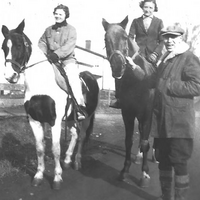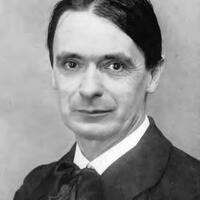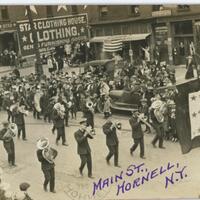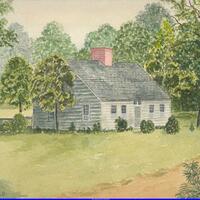This collection contains documents, photographs, and assembled material including letters, telegraphs, and newspaper clippings from the family of General John G. Farnsworth (1832-1895) and noted artist Emma Justine Farnsworth (1860-1952). Included are scrapbooks of newspaper clippings and correspondence, printed material created by or about the Farnsworths, and photographs of the extended Farnsworth family and their friends. Much of the correspondence was written to Sarah Gourlay Farnsworth (1837-1923) following the death of her husband General Farnsworth, in April 1895.
The major figures in the collection are General John G. Farnsworth, Adjutant General for New York State, and his daughter Emma Justine Farnsworth, noted photographer of the Aesthetic movement. She led efforts to raise war relief aid for Europe during WWI.
General John G. Farnsworth served in the American Civil War beginning as a Captain and Assistant Quartermaster appointed by President Abraham Lincoln (1809-1865) to the United States Volunteers, eventually rising to the rank of Brevet Colonel. After the Civil War, he returned to civilian life but remained active in the New York National Guard serving as an officer in the 10th Battalion. Governor Grover Cleveland (1837-1908) appointed him Adjutant General of New York State in 1883, a position he held until 1886. In addition to Presidents Lincoln and Cleveland, he knew Presidents William McKinley (1843-1901), Ulysses S. Grant (1822-1885), and Chester A. Arthur (1829-1886). Also in the collection is correspondence from John Meyer Bowers (1850-1918) who defended former President Theodore Roosevelt in a libel suit. In addition, General Farnsworth belonged to civic organizations such as the Masons and the Military Order of the Loyal Legion of the United States, which was involved in supporting African American troops and federal reconstruction efforts.
The collection contains scrapbooks of newspaper clippings and correspondence compiled by Emma Justine Farnsworth and her mother Sarah Gourlay Farnsworth that document Emma’s artistic career. Emma Farnsworth was trained in the fine arts, and became a noted photographer specializing in genre and figure studies. Her work was first featured at the Second Joint Annual Exhibition of Photography in Boston, MA in 1888. She went on to exhibit worldwide. Of particular note is a copy of her published book In Arcadia (1892) that is annotated with the names of the models, a unique record held by the ACHA. Emma Farnsworth’s photography can be found in the holdings of the Getty Museum (Los Angeles, CA), National Gallery of Art (Washington, D.C.), New York Public Library (New York, NY), and the Metropolitan Museum of Art (New York, NY). At the start of WWI Emma Farnsworth turned her attention to raising funds for aid to Europe. She was the New York State chairman for the Women’s Section of the Commission for Relief in Belgium.
The Farnsworth family had wide social circles stretching across the United States, but they were particularly well connected in their home city of Albany, New York. The family of Thomas Worth Olcott (1795-1880), owners of the historic Ten Broeck Mansion, were friends of the Farnsworth family. Thomas Worth Olcott’s youngest son, Dudley Olcott (1938-1919) features in several of the photographs in the collection. Like General Farnsworth, Dudley Olcott
served in the Civil War, serving as an officer in the 25th New York Volunteers. Emma Farnsworth was a part of an extensive circle of artists on the East Coast who were recognized for their talent worldwide. Two artists Emma Farnsworth was acquainted with were Lydia Field Emmet (1866-1952) and Elizabeth Astor Chanler Chapman (1866-1937). Both Lydia Emmet and Elizabeth Chapman appear in photographs in Emma Farnsworth’s book In Arcadia.
The Farnsworth Family Papers illustrate 19th century mourning customs, 19th century social networks in Albany, New York and the East Coast, and religious networks between the Episcopal and Catholic churches in 19th century Albany, New York. The newspaper clippings discuss Civil War commemoration, the lives of Civil War Generals, 19th century history of Albany, New York, the Aesthetic movement, photography, women artists, and current events c. 1890-1918.
Collection access note: As part of the aesthetic movement in the late 19th century, some photographers used children as models, some of them posed unclothed. These photographs are not included in their entirety. Researchers may make in-person appointments via our researcher agreement to view the entire collection. Please contact the Albany County Historical Association for more information.
Thank you to the following for their work on this collection:
ACHA Staff and Interns: Bradt, Aaron (Project Implementation, Digitization, Meta-data); Kosto, Kathryn (Arrangement and Transcriber)
ACHA Archive Volunteers: Bartram, Carol (Transcriber); Berger, Dan (Transcriber); Berron, Cristina (Transcriber); Rector, Rebecca (Transcriber); Sarchiapone, Marie (Transcriber); Sears Doherty, Patricia (Transcriber); Weise, Kathryn (Transcriber); Thaler, Mark (Transcriber); Thompson, Jessica (Transcriber) Wentz, Deborah (Transcriber); Younge, Lee H. (Transcriber); Zunon, Ellen (Transcriber).




